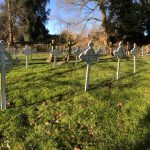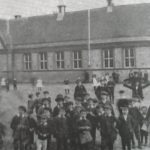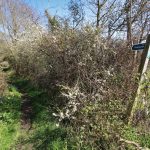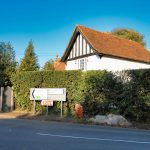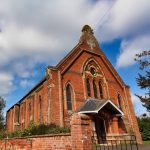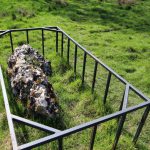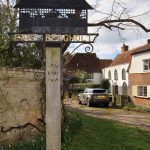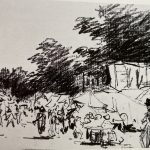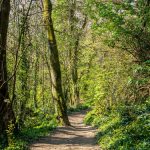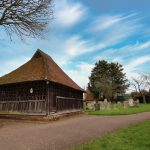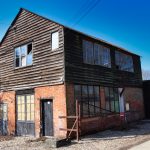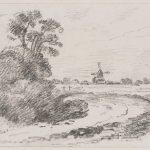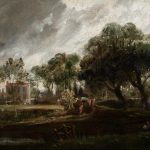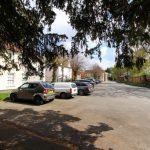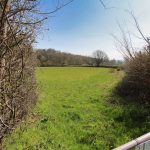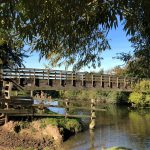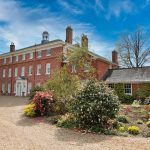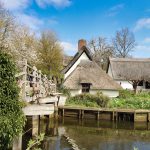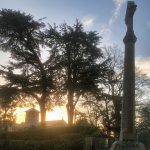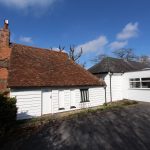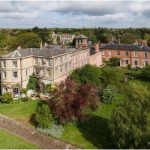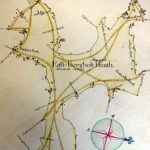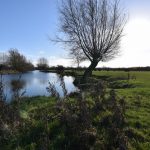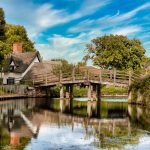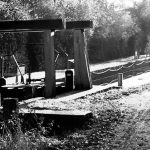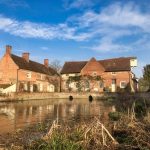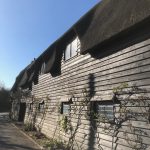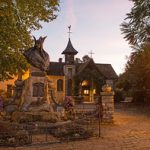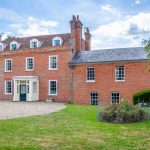Old Hall over the years has been in many different forms including St Mary’s Abbey (1849-1940) and The Franciscan order of Friars Minor (1945-1973)
This would have been the main school for youngsters from East Bergholt and the surrounding area age 5-15 and could accommodate around 50 pupils in mixed classrooms with seperate playgrounds for boys and girls.
Better known now as "Touchy Lane", "Procession Lane" originally a footpath connecting the top of Touchy Hill with East End.
Thought to have been bought down from Scotland or Scandinavia during the last Ice Age, this impressive Glacial Erratic Boulder on the corner at Bakers End.
In 1644 at the height of the Civil War, the Puritans of the village declared their rector to be 'malignant' and replaced him, eventually leading East Bergholt to have a licence for a 'dissenters' chapel and from which this non-conformist and Independent Church was formed in 1672.
A 12th Century Augustinian Priory on the border between East Bergholt and Bentley, founded in 1188 by Wimer the Chaplain (servant of Henry II and sheriff of Suffolk and Norfolk), and was in use until Cardinal Wolsey’s downfall in 1525.
The Green, the heart of the village and for many years prior to ‘enclosure’ in 1817 a meeting place for exchange of trade, the village fair, gatherings for celebrations, coronations, wars, or as depicted in John Constables ‘Celebration of the General’ 1815, a procession held for the poor people in the village to celebrate the peace treaty, however today all that remains of the green is this tiny patch of grass which houses the village sign.
Like many towns and villages throughout the country, East Bergholt held an annual fair for many centuries, in fact an early record by order of the Lord of the Manor in the reign of Henry VI recorded that the bailiff should collect rents and profits from stalls ‘next the graveyard of East Bergholt Church and to answer for them’, and there were many attempts to have it banned in the 17th Century when warrants were issued for anyone who set up a booth or stall (1685).
During WW2, nicknamed ‘Songthrust’ and in case of invasion of the Germans, The East Bergholt resistance operated from their underground base situated in woodland known as ‘The Commons’, about 15 metres off Dead Lane, originally a cart track but now a well used footbath to the west of the village bordering the A12.
Work on the Bell Tower of St Mary The Virgin Church began in 1525 with the assistance of Cardinal Wolsey, however with his downfall cut short, all work ceased in 1530 and the Bell Cage was erected as a temporary measure in 1531.
W T Wheeler & Sons were builders and joiners based at Wheelers Yard, better known as Pakefield works (now Suffolk Sheds) at the end of Putticks Lane, and built many well known properties around the village including Constable Hall and the Primary School.
The Windmill which was located on the old heath at ‘Windmill Bank’, part of ‘Pitts Farm’ which extended east of the Donkey Track to the fields up to Gandish Road and across to what is now Mill | Heath Road & Gandish|Straight Road
East Bergholt House, home of the Constables, demolished C1840.
All that remains is that of the Coach House, Laundry and stable block, known today as The Court (private residence)
Whilst many of us remember the work of John Ryan, best known for ‘Captain Pugwash’, but few of us know the connection to East Bergholt.
Church Plain, the open space between St Marys Church, Old Hall and Old Chapel House at the top of Rectory Hill, was the site of a market which sold food and provisions and having housed a maypole most likely served as a medieval market place.
As you leave the village between East Bergholt and Cattawade, on the left hand side at the top of the hill, next to Procession Lane, you will find 'Touchy Field'
A wooden arch bridge across the river Stour in Suffolk on a footpath leading from the town of East Bergholt to the little hamlet of Flatford.
There has been a significant property on this site since the 13th Century, however the current property ‘Stour’ (West Lodge) was believe to be built in the 18th century, with editions added in the 19thC and is certainly one of the principle mansions of East Bergholt today.
Bridge Cottage was depicted in many of John Constables paintings of Flatford, and dates from around 1700, however no doubt there were other buildings on the site prior to this.
By the 19th century, it was converted into two dwellings, each family lived with a small parlous with access to a single bedroom in the attic, accessed in one by a twisting staircase, and the other a loft ladder.
On the 24th February 1909, local newspapers reported a story with the headlines ‘Runaway Nun: Escape from East Bergholt Convent, Struggle with Pursuers’!
Named after Mr Edward Lambe, Lord of the Manor of "Illaries, (the Illaries manor house was the site of Manor Farm, East End), the Lambe School served as a school house for the village for many years.
It was restored by East Bergholt Society in 1974, and is now available for hire for Weddings, Meetings, Social gatherings etc. One regular monthly event is the Saturday East Bergholt "Farmers Market" for local produce.
The earliest records date back to only the 14th Century and by which time Old Hall was established on its present site. Having been owned by Norman knights, wealthy Earls of Oxford, by London bankers and country squires, by staunch Puritans and Catholic religious orders, by soldiers in transit and now since 1974 The Old Hall Community.
Throughout the medieval (and postmedieval periods) the central part of the parish was dominated by an extensive area of open heathland (East Bergholt Heath), criss-crossed by trackways leading to Dodnash Priory, Brantham, Flatford and Wenham.
In the days before road, a Sudbury Act of Parliament passed in 1705 giving the town authority to create a ‘navigation’ and bring barges up to 45ft long to Ballingdon, so the Corporation built locks downstream to Flatford, the lowest point for fording the river regardless of the tide, and the trade in bulky commodities such as bricks and grain begun.
Built originally in 1705 and became the inheritance of John Constables fathers ‘Golding’ estate, the bridge at Flatford was probably amongst John Constables earliest recollections and was indeed included in many of his sketches over the years.
The first lock at Flatford was installed in the early eighteenth century. It was turf sided and located about 20 yards to the north of the present lock.
Flatford Mill, immortalised by John Constable and his painting of The Haywain and the Mill which is as recognisable today as it was then.
Attached to the Mill, is the 17th Century Millers cottage
The Granary would have been built by the mill owner and so from early times it belonged to the mill. The main granary and outbuildings would have been used to store all sorts of things, including wool, wood, coal and grain and flour and at one time was owned by John Constable’s father.
East Bergholt is twinned with Barbizon in France, a commune town in the Seine-et-Marne in north-central France, located near the Fontainebleau Forest, its twinning agreement, signed over 40 years ago and was the driving force of Lady Anne Wake-Walker who was a guiding light of the twinning agreement for almost all of that time, as she had lived in Paris and spoke fluent French.
Maria Bicknell was daughter of the Solicitor to the Admiralty, her grandfather rector of East Bergholt and where Constable and Maria first met in 1800 when she was just 12 years old and Constable in his early 20’s. The two fell in love in 1809, but partly because of the rector’s opposition they did not marry until 1816.

